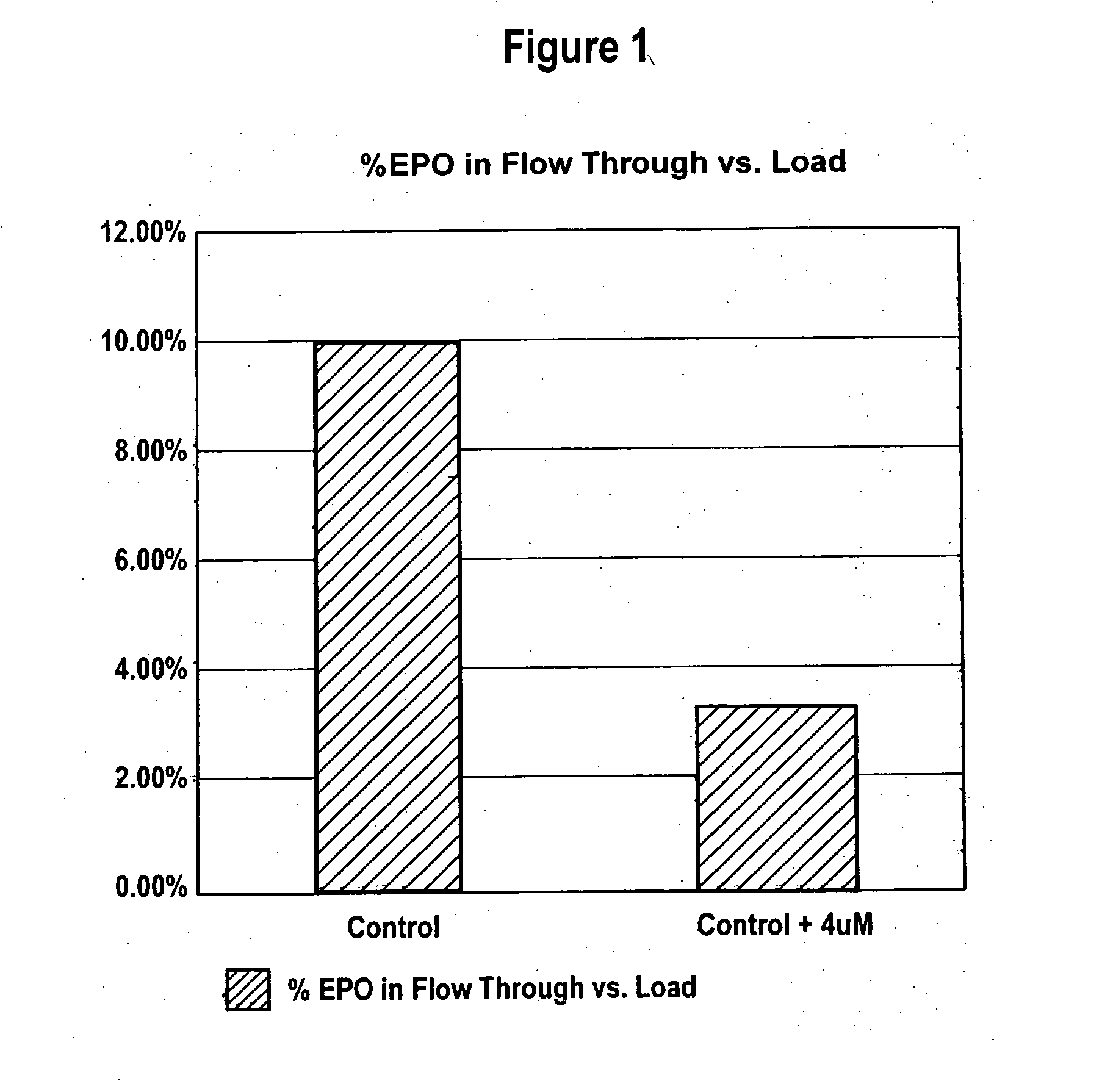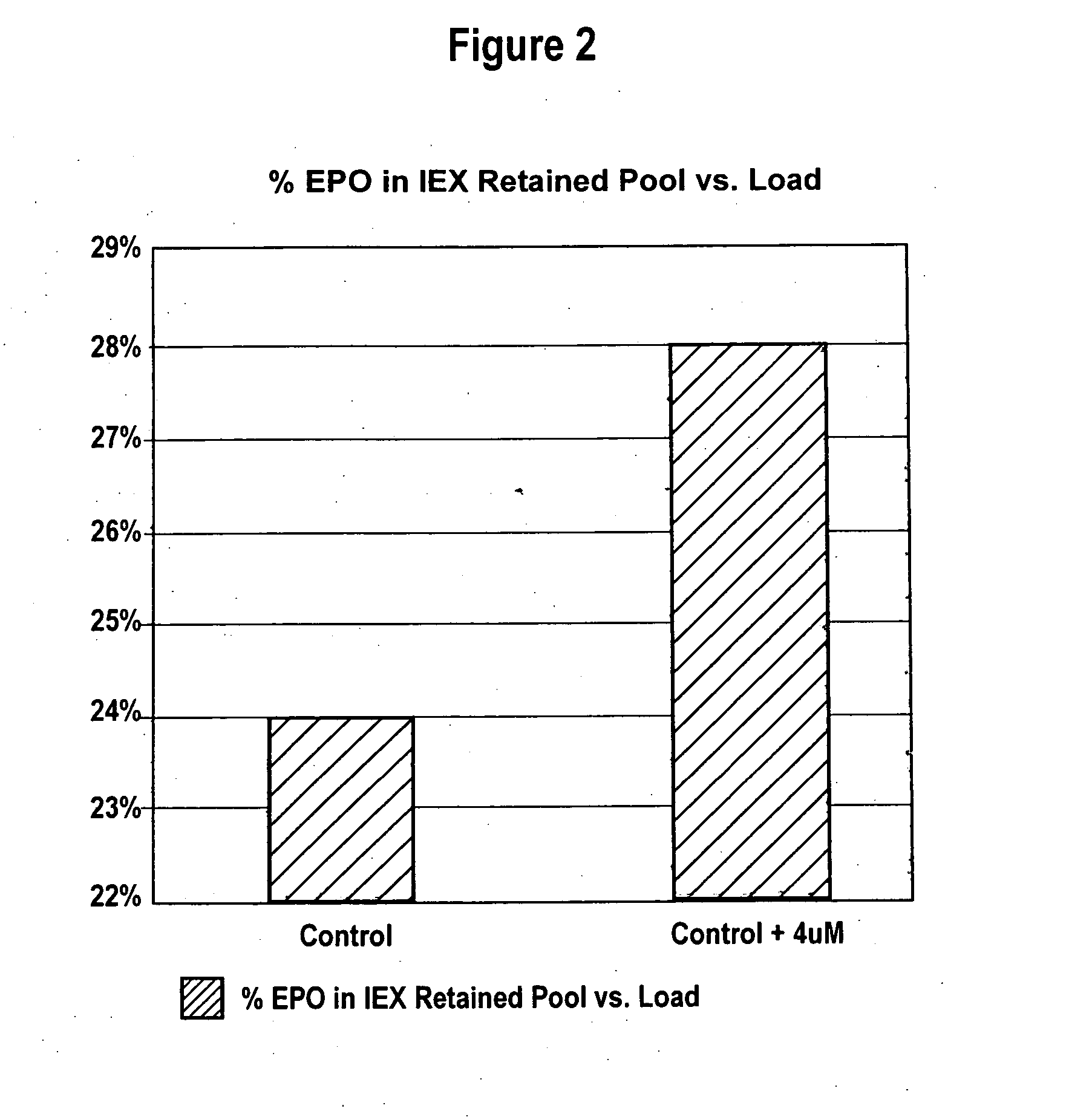Production of glycoproteins using manganese
a technology of glycoproteins and manganese, which is applied in the field of cell culturing methods and media containing manganese, can solve the problems of complex biosynthesis of glycoproteins such as epo, and achieve the effect of increasing the sialylation of a glycoprotein composition
- Summary
- Abstract
- Description
- Claims
- Application Information
AI Technical Summary
Benefits of technology
Problems solved by technology
Method used
Image
Examples
example 1
[0069] Protein Production Methods
[0070] This example describes a cell culture method for production of recombinant human erythropoietin (rHuEPO, SEQ ID NO: 3) or darbepoetin (SEQ ID NO: 2). A DHFR minus CHO cell line was stably transfected with a genomic DNA sequence containing the human erythropoietin gene (Lin U.S. Pat. No. 4,703,008, incorporated herein by reference) or a cDNA sequence encoding darbepoetin gene (SEQ ID NO: 1). Roller bottles (850 cm2) were inoculated with 1.7×107 total cells and grown for 5 days in 450 mls of 1:1 DMEM / F-12 media (Gibco) containing 5% serum. The cultures were washed once with PBS and then incubated in three discrete batch harvest cycles. Media was replaced twice in the first 14 days; the third cycle was 5 to 6 days in duration. For erythropoietin, at each harvest, the conditioned culture medium was completely removed and fresh 1:1 DMEM / F-12 without serum (“Standard Media”) was added to replace the harvested media. When manganese was included in t...
example 2
[0071] Quantitation of rHuEPO or Darbepoetin in Harvested Culture Media
[0072] 200 μl of harvested media produced according to Example 1 was analyzed for the amount of rHuEPO or darbepoetin produced, using reverse phase HPLC. Samples were separated on a polymer PLRPS (4.6 mm×150 mm; 1000 Å (Polymer Laboratories) under reverse phase conditions (linear AB gradient from 30%-55% B over 17 minutes; buffer A: 0.1% TFA in H2O, buffer B: 0.1% TFA in 90% CH3CN (Sigma)). The retention time for rHuEPO or darbepoetin within the culture media was compared with a purified rHuEPO or darbepoetin standard (Amgen Inc.). Waters Millennium Software was used to manually integrate the rHuEPO or darbepoetin peak areas to ensure consistent integration. Integrated peak areas of unknown samples were quantitated by comparison to a known standard curve.
example 3
[0073] Effect of Manganese on Highly Sialylated and Lower Sialylated Forms of Erythropoiesis-Stimulating Molecules
[0074] CHO cells producing rHuEPO were grown as described in Example 1 with and without added 4 μM MnCl2. Conditioned media collected after the third harvest cycle was analyzed for percent recovery of highly sialylated forms of rHuEPO. CHO cells producing darbepoetin were grown as described in Example 1 with and without added 4 μM MnCl2. Conditioned media collected after each of the three harvest cycles was analyzed.
[0075] Lower sialylated forms of rHuEPO were separated from highly sialylated material using anion exchange method as described in Elliott et al., Biochemistry, 33(37):11237-45 (1994), herein incorporated by reference in its entirety. Briefly, highly sialylated rHuEPO, having a strong negative charge, binds to the resin while lower sialylated rHuEPO washes through the column. Cell culture media from each roller bottle obtained as described in Example 1 was ...
PUM
| Property | Measurement | Unit |
|---|---|---|
| pH | aaaaa | aaaaa |
| pH | aaaaa | aaaaa |
| Accelerating voltage | aaaaa | aaaaa |
Abstract
Description
Claims
Application Information
 Login to View More
Login to View More - R&D
- Intellectual Property
- Life Sciences
- Materials
- Tech Scout
- Unparalleled Data Quality
- Higher Quality Content
- 60% Fewer Hallucinations
Browse by: Latest US Patents, China's latest patents, Technical Efficacy Thesaurus, Application Domain, Technology Topic, Popular Technical Reports.
© 2025 PatSnap. All rights reserved.Legal|Privacy policy|Modern Slavery Act Transparency Statement|Sitemap|About US| Contact US: help@patsnap.com



